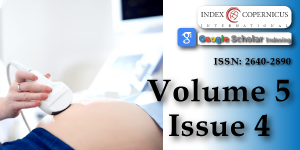Idiopathic ascites following caesarean section: A case report
Main Article Content
Abstract
Ms X is a 40-year-old gravida 12, para 2 + 9 woman, who was admitted for an elective caesarean section at 38 weeks gestation following the previous two caesarean sections. Ms X had abdominal distension and generalised abdominal tenderness in the postoperative period. On investigation, she was found to have an elevated white cell count (WCC), C - Reactive Protein (CRP) and creatinine with free fluid in the abdomen on imaging but there was no evidence of perforation of any visceral organ. Ms X was treated conservatively for sepsis, an Acute Kidney Injury (AKI) and post-operative ileus and her symptoms gradually resolved. This is a case of idiopathic ascites post caesarean delivery with no clear cause.
Article Details
Copyright (c) 2023 Tate J, et al.

This work is licensed under a Creative Commons Attribution 4.0 International License.
Sandhu N, Singh S. An unusual case of postoperative ascites after cesarean section. International Journal of Reproduction, Contraception, Obstetrics and Gynecology. 2020 Jun 1;9(6):2635-8.
Roberts CL, Nippita TA. International caesarean section rates: the rising tide. Lancet Glob Health. 2015 May;3(5):e241-2. doi: 10.1016/S2214-109X(15)70111-7. Epub 2015 Apr 9. PMID: 25866356..
Dempsey A, Diamond KA, Bonney EA, Myers JE. Caesarean section: techniques and complications. Obstetrics, Gynaecology & Reproductive Medicine. 2017; 1:27(2);37-43.
Alabrah PW, Agbo J, Agoro ES. Preeclampsia complicated by antenatal & postnatal ascites. European Journal of Medicine & Health Sciences. 2019;1:5.
Caesarean Section. Consent Advice No. 7, Royal College of Obstetricians & Gynaecologists. Greentop Guidelines. 2009.
Ko PC, Lo TS, Ashok K. Urinary ascites with elevated blood creatinine following cesarean section indicating bladder injury. Taiwan J Obstet Gynecol. 2011 Dec;50(4):537-9. doi: 10.1016/j.tjog.2011.10.027. PMID: 22212334.
Al-Busafi SA, Ghali P, Deschênes M, Wong P. Chylous Ascites: Evaluation and Management. ISRN Hepatol. 2014 Feb 3;2014:240473. doi: 10.1155/2014/240473. PMID: 27335837; PMCID: PMC4890871.
Thompson KA, Al Khabbaz A. Incidental Chylous Ascites at the Time of Cesarean Section. Case Rep Obstet Gynecol. 2015;2015:530210. doi: 10.1155/2015/530210. Epub 2015 Jun 15. PMID: 26171264; PMCID: PMC4485536.
Betran AP, Ye J, Moller AB, Souza JP, Zhang J. Trends and projections of caesarean section rates: global and regional estimates. BMJ Glob Health. 2021 Jun;6(6):e005671. doi: 10.1136/bmjgh-2021-005671. PMID: 34130991; PMCID: PMC8208001.
Aponte EM, Katta S, O'Rourke MC. Paracentesis. In: StatPearls. Treasure Island (FL). 2022. https://www.ncbi.nlm.nih.gov/books/NBK435998/
Epstein NE. Multidisciplinary in-hospital teams improve patient outcomes: A review. Surg Neurol Int. 2014 Aug 28;5(Suppl 7):S295-303. doi: 10.4103/2152-7806.139612. PMID: 25289149; PMCID: PMC4173201.

